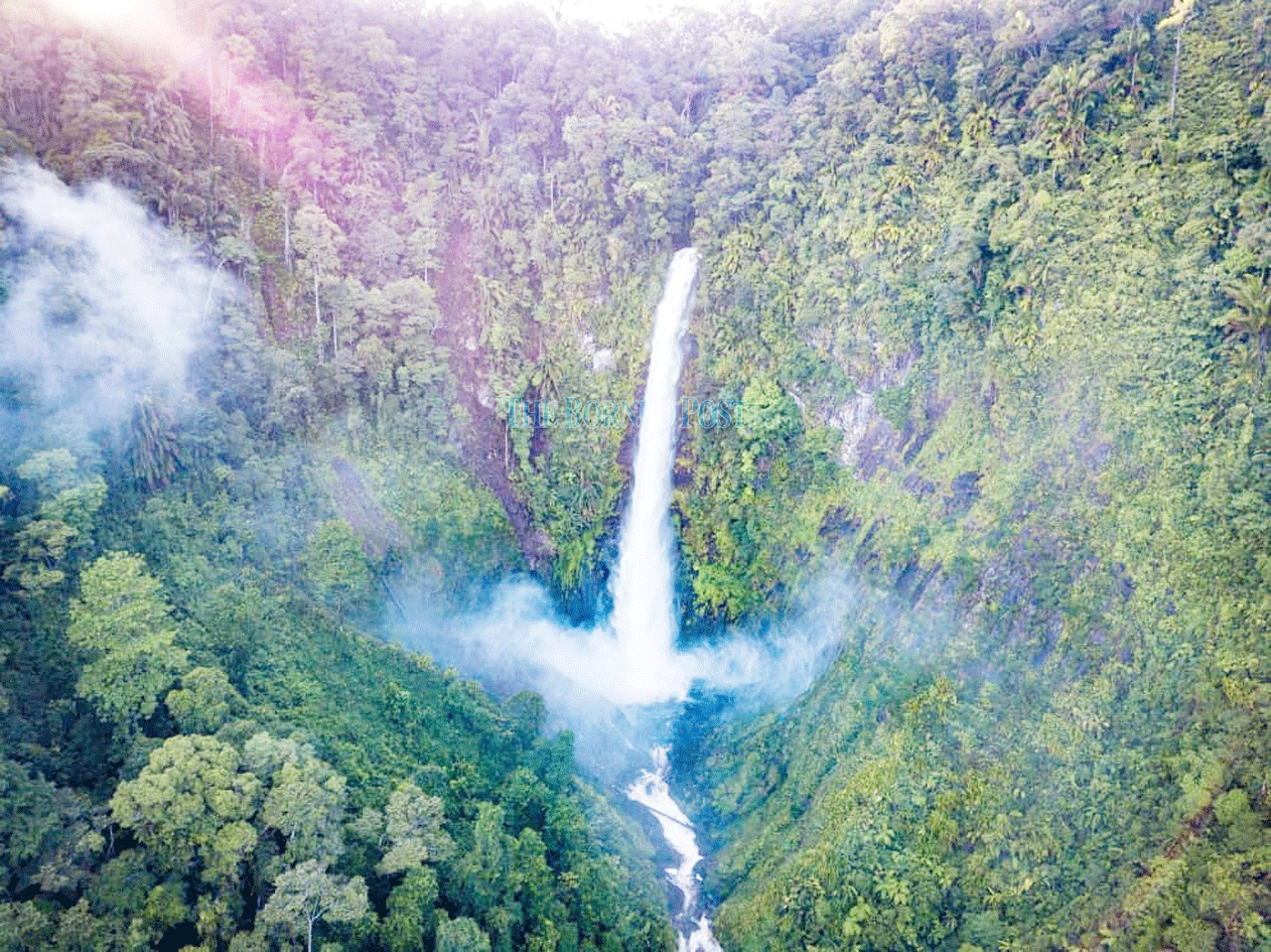
A view of Eastern Julan Waterfall taken with a drone of one of the Hashers.
HAVE you ever wondered why waterfalls trigger an overwhelming sense of joy among people?
A scientific theory has it that waterfalls can generate positive vibes, given that negative ions from the water, hitting the bloodstream, help increase the production of serotonin – the chemical responsible for relieving stress and depression, and also boosting positive energy.
Whether the theory has been scientifically proven or not, the waterfalls in Sarawak have fascinated many locals to explore more.

The 11 hashers from Kuching, Bintulu and Miri spent five days and four nights hiking to the Eastern Julan Waterfall.

Climbing up the rugged terrain requires a lot of stamina and mental strength.
Recently, the Miri Hash House Harriers (HHH) completed a five-day, four-night expedition to the Eastern Julan Waterfall, one of the highest in Malaysia, rushing down a stupendous 300 metres from the cliff of the plateau into the green rainforest below.
The 11 Hashers, aged between 35 and 65 years, and comprising Colin Hang, the team leader, Goh Lee Na, Ling Kie King, Wong SIong Hang, Ngu Neng Ho, Wong King Chui, Sii How Ping, Ngu Ting Lang, Thien Kim Fook, Chong Mi Chin and Danny Tiong, were from Bintulu, Miri and Kuching.
They described the expedition as nothing like what they had experienced before.
Miri HHH vice-chairman Ling Kie King said at first, they had mixed feelings but when they reached the waterfall, their initial foreboding evaporated instantly amid the absorbing white noise generated by the reverberant cascading waters.
“Unlike many other explored waterfalls, the trail to this Julan Waterfall is the least trodden. So we assigned duties to everyone to avoid a chaotic situation.
“From food to safety gears, the loads for 11 people were quite big and we had to hire seven porters and two rangers to keep us on track,” Ling added.
Bumpy journey
On August 27, they started on a nearly five-hour bumpy ride in a four-wheel-drive vehicle from Miri to a farmhouse homestay. From there, they trekked to 380 metres above sea level to reach the first base camp, the starting point of their ascent to the waterfall.
After an overnight rest, they trekked to base camp A, 550 metres above sea level. The hilly terrain and almost vertical slopes posed a big test to physical and mental stamina.
“The one-and-a-half-day trek to the Eastern Julan Waterfall takes a lot of endurance and patience without which, you could easily give up,” Ling said.
The trails were made even more challenging by the exposed tree roots and leeches that latched on to your skin for a blood-feed.

A bloated leech after being fed blood-feed.
“It’s horrible, especially for people with vermiphobia – the unpleasant crawling sensation all over the skin would give you goose bumps.”
Although Eastern Julan Waterfall is less powerful than the Western Julan Waterfall, it offers similar adrenalin-rushing vim of white water torrents and an equally adventurous trek.
“We rested for the night at base camp A. Settling in was another challenge. For safety, we sprinkled sulphur powder around the perimeter of our camps to keep away prowling animals at bay.
“Thankfully, nothing out of the ordinary happened during the night and we woke up fresh and ready to go,” Ling recalled.
Usun Apau plateau
This tableland – a National Park of intense splendour and often referred to as the garden of eden – is located some 170km south-southeast of Miri.
An old volcanic plateau near the Indonesian border, it is said to be discovered in 1951 by Tom Harrison, the Sarawak Museum curator.
Since the 1950s, several expeditions have been organised to discover this “hidden untouched world.” In 1955, four Oxford students – Guy Arnold (team leader), Gordon Pickles (botanist), Colin Campbell (geologist) and Tom Chavasse (zoologist) went on a field trip to the Borneo Highlands to collect information for their research.
Their trail was revisited in 2019 by five Oxford students in an expedition to highlight conservation issues faced by Usun Apau Plateau.
Between March and June 2004, two Sarawak expeditions reached the summit of the Western Julan Waterfall.
“The jungles around the waterfalls remain untouched and largely uninhabited, except for the Penans, because of the steep slopes.
“Though the 11 of us have been hiking a lot, we still found the expedition very challenging. We took special care in preparing the climbing gears, dry food, water ration and safety kits, among others, as we couldn’t afford to run short in case of an emergency,” Ling explained.
The pristine Eastern Julan Waterfall and the colder atmosphere 1,000 metres above sea level quickly revitalised weary limbs and minds with awe-inspiring sights and a heightened sense of accomplishment.
“The rejuvenating and spellbinding beauty made it well worth all the hard work that went into the planning,” Ling noted.

The expedition team.
Tourism development necessary
Though Usun Apau National Park is a well-known natural heritage, the two waterfalls are a powerful tourist attraction.
“The unusual landscapes should be developed into easier pathways for hikers so that they, too, can enjoy the waterfalls.
“The Covid-19 pandemic has changed the way visitors, particularly locals, spend their holidays. Many are turning to explore Sarawak. With better footpaths, the Julan Waterfalls, can become one of the major tourist attractions and bring more business opportunities,” Ling said.
Sarawak is a land “full of natural attractions” which should be developed and promoted to attract more adventure travellers, he added.
